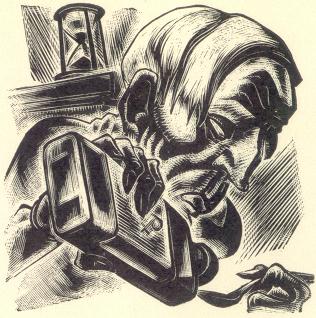An Elderly Gentleman : IMAGE 132 : Hourglass
The Gentleman’s life-giving medication—his barrier against physical disintegration—has been depleted; the hourglass glimpsed over his shoulder reveals the nearness of the end. In Ward’s dialectical style, this image (132) restages its homologous partner, I76, and contrasts this fragile marker of the vanishing seconds of the Gentleman’s life with that falsely reassuring wall of medicine bottles.
The emblematic hourglass, which figures in literature as early as Bunyan’s Divine Emblems (1791)10, and The New-England Primer, may be interpreted as a figment of the Elderly Gentleman’s disturbed imagination. (Surely the Gentleman might have collected an antique hourglass—but would he keep it by itself on a bureau?) It further argues that the small images tend to be iconic rather than naturalistic, and that they also tend to frame the character’s phenomenological experience of events rather than the events, themselves.
Note that Ward continues the metaphor of the hourglass by gouging away the block below the bottle. The disintegration that began in I94 (subtly suggested perhaps by the diagonal line) is spreading at an alarming speed, and without the precious medication there will be no stopping it. Notice that Ward has exaggerated the bottle size, in order to further characterize the Elderly Gentleman's debilitating dependence upon it. For similar reasons, he has gouged out the block around the Elderly Gentleman's hand clutching the spoon, severing it from the rest of the body, and configured it to suggest a creature's misshapen claw
Print view

